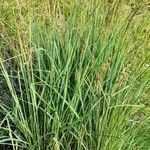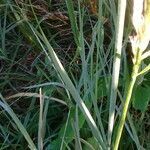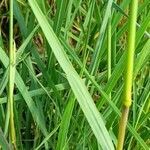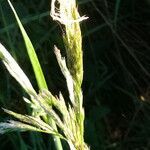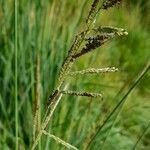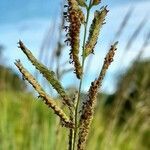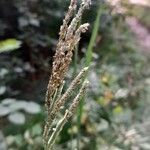Coarsely tufted, erect, rhizomatous perennial, 0.1-2.5 m high; basal sheaths densely hairy; culm nodes pubescent. Leaf blade 250-600 x 4-15 mm; ligule an unfringed membrane. Inflorescence with 10-30 secund racemes, closely spaced on 120-300 mm long central axis; spikelets arranged in 4 rows. Spikelets 1.6-2.8 x 1.2-1.4 mm, ovate, dorsiventrally compressed, awnless, yellowish green; glumes unequal; lower glume absent, upper glume 3-nerved; lower lemma and upper glume fringed on margins with silky hairs giving a woolly appearance. Florets 2; lower floret sterile, lemma equal and similar to upper glume but flat on back; upper floret bisexual, lemma similar in texture to, to firmer than glumes, uniformly striate to irregularly striate, obtuse, entire, faintly nerved, indurated, glabrous, sometimes minutely punctiform, margins narrow and inrolled, clasping only edges of palea; anther 1.0-1.2 mm long. Flowering time Oct.-Apr.
Perennial from a short rootstock. Culms robust, up to 2 m tall, glabrous. Leaf sheaths densely hispid, long hairs at the mouth; leaf blades linear, 15–50 × 0.5–1.5 cm, glabrous or pilose at the base, apex attenuate; ligule 3–5 mm. Inflorescence axis 10–30 cm; racemes 10–25, 8–15 cm, narrowly ascending or suberect; spikelets paired; rachis ca. 0.5 mm wide. Spikelets light green or purplish, ovate, 2–3 mm, sharply acute; upper glume membranous, 3-veined with laterals marginal, appressed-pubescent on back, margins densely fringed with long white hairs; lower lemma similar but glabrous on back; upper lemma elliptic, striate, obtuse. Fl. and fr. May–Oct. 2n = 40, 60.
Coarsely tufted, erect perennial 100-2 500 mm high; rhizomatous; basal sheaths densely hairy; culm nodes pubescent. Leaf blade 250600 x 4-15 mm; ligule 2-9 mm long, conspicuous. Inflorescence central axis 120-300 mm long; racemes 10-30, closely spaced on axis; spikelets arranged in four rows, secund. Spikelet 1.6-2.8 x 1.2-1.4 mm, ovate, yellowish-green; upper glume 3-nerved; upper glume and lower lemma fringed on margins with silky hairs giving a woolly appearance; upper lemma uniformly to irregularly striate; anther 1.0-1.2 mm long.
Densely cespitose, stout, erect, to 2 m; upper blades and sheaths glabrous, lower sheaths and base of the lower blades hirsute; panicle much surpassing the upper lf, dense, the numerous (8–30) racemes erect or appressed, 5–10 cm; spikelets elliptic, acute, 2.2–2.8 mm; glume white-villous; sterile lemma nearly glabrous; fertile lemma shorter and blunt; 2n=40, 60. Waste ground; native of trop. Amer., now widespread from s. U.S. (n. to Va.) s. to Argentina.
Perennial, rhizomatous and tufted (coarsely and erect), up to 2.5 m high. Leaf blades 250-600 mm long, 4-15 mm wide; ligule conspicuous, membranous, 2-9 mm long. Basal sheaths densely hairy. Spikelets 1.6-2.8 mm long, 1.2-1.4 mm wide. Inflorescence with central axis 120-300 mm long; racemes 10-30, closely spaced on axis; spikelets arranged in 4 rows, fringed with white hairs to give a woolly appearance.
Racemes usually 10–20, borne along an axis 10–20 cm. long, each raceme 4–13 cm. long, the spikelets paired in 2–4 rows on a rhachis c. 1 mm. wide.
Like P. dilatatum but often taller, spikelets 1.6-2.8 mm long, in 10-30 spikes.
Superior glume sparsely pilose on the surface, ciliate on the margins.
Spikelets 2–2.8 mm. long, 1.2–1.5 mm. wide, ovate, yellowish green.
Tufted perennial 1–2 m. high.
Culms 80–250 cm. high.
Tufted perennial.
